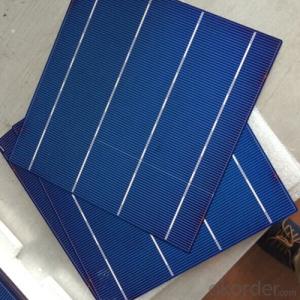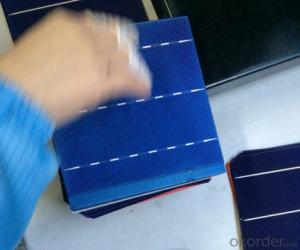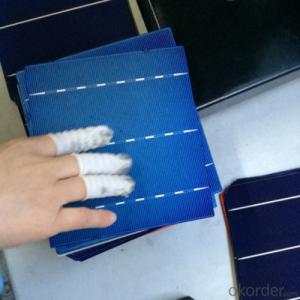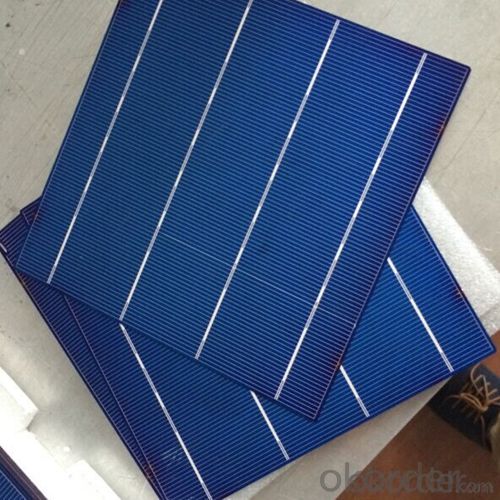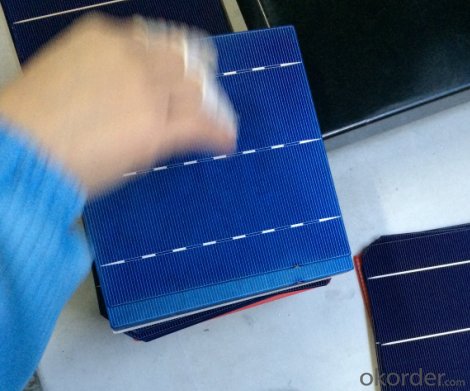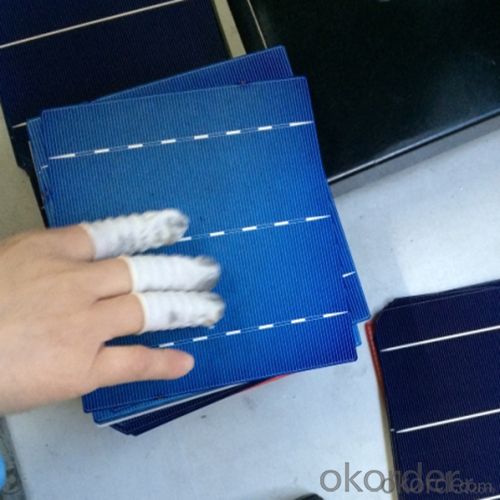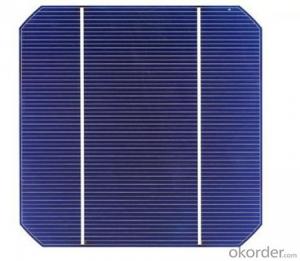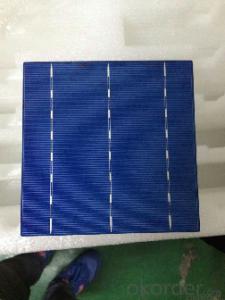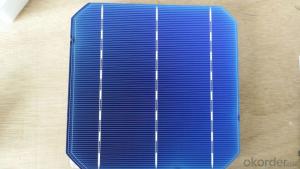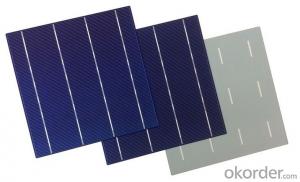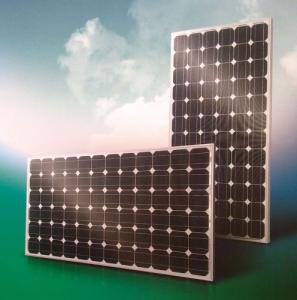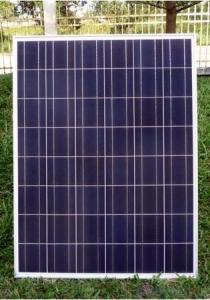Elon Musk Inspired Poly 3bb 4bb Solar Cells with Low Price 156*156mm
- Loading Port:
- Shanghai
- Payment Terms:
- TT or LC
- Min Order Qty:
- 30000 pc
- Supply Capability:
- 3000000 pc/month
OKorder Service Pledge
OKorder Financial Service
You Might Also Like
Product description
Poly Solar Cells 156*156mm B Grade Low Price 3BB 4BB
A solar cell, or photovoltaic cell, is an electrical device that converts the energy of light directly into electricity by the photovoltaic effect, which is a physical and chemical phenomenon.[1] It is a form of photoelectric cell, defined as a device whose electrical characteristics, such as current, voltage, or resistance, vary when exposed to light. Solar cells are the building blocks of photovoltaic modules, otherwise known as solar panels.
Solar cells are described as being photovoltaic irrespective of whether the source is sunlight or an artificial light. They are used as a photodetector (for example infrared detectors), detecting light or other electromagnetic radiation near the visible range, or measuring light intensity.
In contrast, a solar thermal collector supplies heat by absorbing sunlight, for the purpose of either direct heating or indirect electrical power generation from heat. A "photoelectrolytic cell" (photoelectrochemical cell), on the other hand, refers either to a type of photovoltaic cell (like that developed by Edmond Becquerel and modern dye-sensitized solar cells), or to a device that splits water directly into hydrogen and oxygen using only solar illumination.
Advantage Of Poly Solar Cell 4BB 3BB
1: High quality cell, Level B cell (14%—17.5%)
2.Dimensione:156*156mm Diagonal:200mm
3: Qualified certification: TUV,CE certification.
4: Warranty: five years for whole unit
Usage/Application Of Poly Solar Cell 4BB 3BB
1.The absorption of light, generating either electron-hole pairs or excitons.
2.The separation of charge carriers of opposite types.
3.The separate extraction of those carriers to an external circuit.
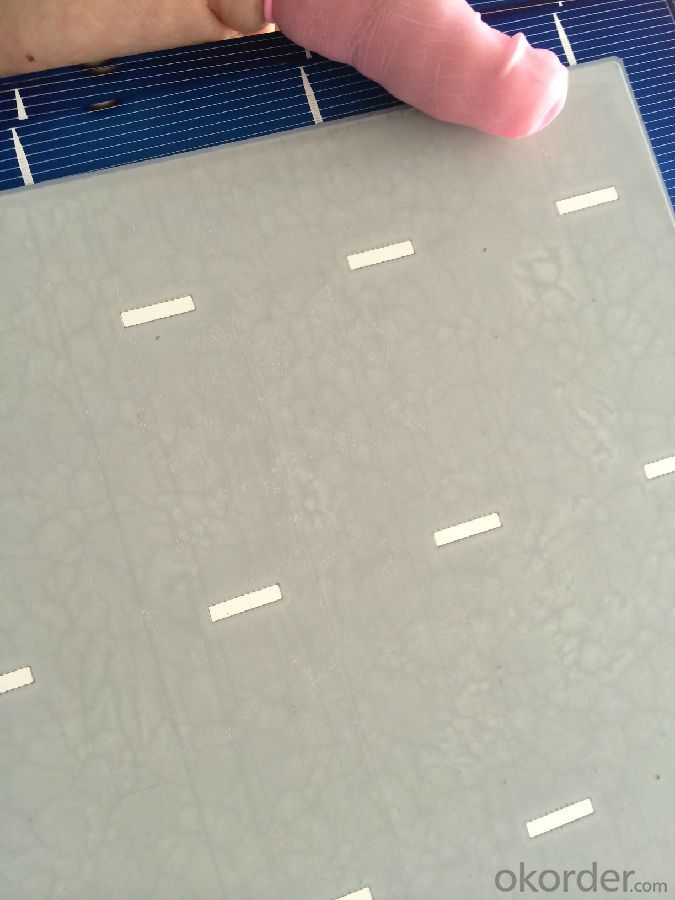
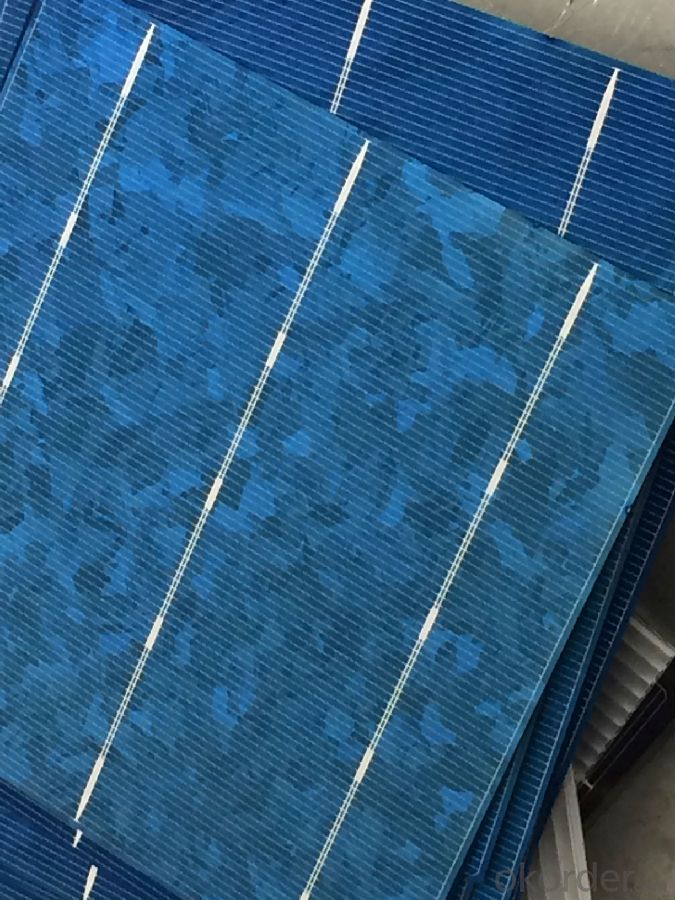
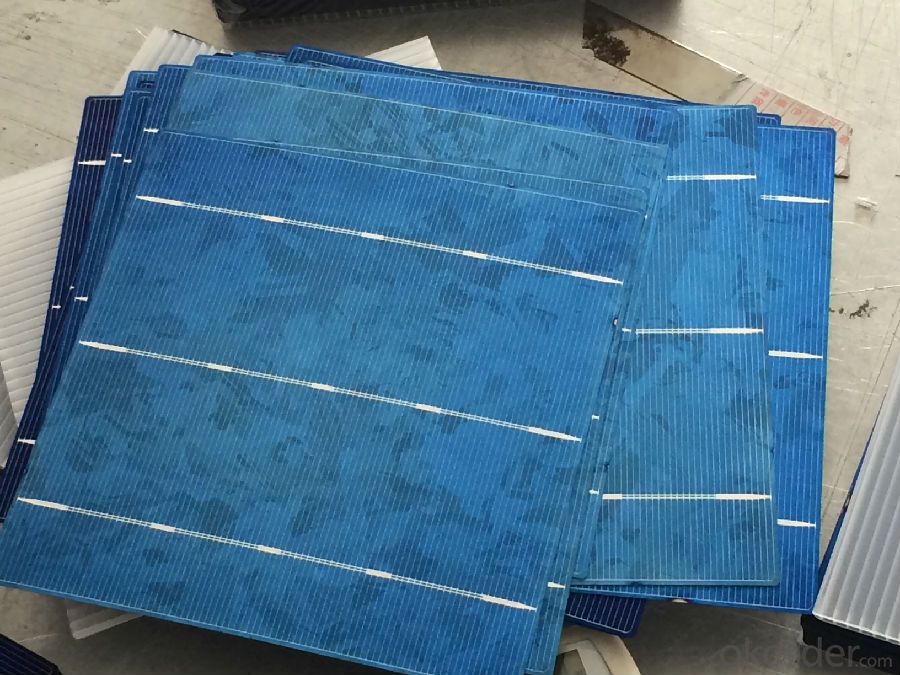
Electrical Characteristic
Efficiency (%) | Pmpp (W) | Umpp (V) | Impp (A) | Uoc (V) | Isc (A) | FF (%) |
17.25 | 4.197 | 0.524 | 7.992 | 0.62 | 8.458 | 80.03% |
17 | 4.137 | 0.524 | 7.876 | 0.619 | 8.353 | 80.01% |
16.75 | 4.076 | 0.522 | 7.81 | 0.617 | 8.286 | 79.73% |
16.5 | 4.015 | 0.518 | 7.746 | 0.613 | 8.215 | 79.73 |
16.25 | 3.955 | 0.515 | 7.683 | 0.61 | 8.144 | 79.61% |
16 | 3.894 | 0.512 | 7.613 | 0.608 | 8.075 | 79.31% |
15.75 | 3.833 | 0.51 | 7.534 | 0.605 | 8.058 | 78.62% |
15.5 | 3.772 | 0.508 | 7.453 | 0.604 | 8.02 | 77.87% |
15.25 | 3.771 | 0.505 | 7.35 | 0.604 | 9.997 | 76.83% |
15 | 3.65 | 0.503 | 7.271 | 0.604 | 7.989 | 75.64% |
14.5 | 3.529 | 0.499 | 7.067 | 0.604 | 7.988 | 73.14% |
14 | 3.407 | 0.499 | 6.833 | 0.604 | 7.833 | 72.01% |
Intensity Dependence
Intensity [W/m2] | Isc× [mA] | Voc× [mV] |
1000 | 1.00 | 1.000 |
900 | 0.90 | 0.989 |
500 | 0.50 | 0.963 |
300 | 0.30 | 0.939 |
200 | 0.20 | 0.920 |
Packaging & Delivery Of Poly Solar Cell 156mm | |
Packaging Detai | Packaging Detail:Export Carton and Pallet or under customer request. |
Delivery Detail:10-20days | |
FAQ
Q:What price for each watt?
A:It depends on the quantity, delivery date and payment terms
Q:What is your warranty system?
A:Our Solar cells performance guarantees for 25 years
Q:How do you pack your products?
A:We have rich experience on how to pack thecells to make sure the safety on shipment when it arrives at the destination.
Brief introduction of 4bb solar cell
4bb solar cells through the photoelectric effect or photochemical effect directly convert light into electrical energy, which makes use of the photoelectric conversion principle of solar radiation through the semiconductor material electrical energy transformed into a device; the photoelectric conversion process is usually called "photovoltaic hit "affect, therefore, solar cells, also known as" photovoltaic cells.
Working principle of 4bb solar cell
Foundation of working principle of 4bb solar cell is the "photovoltaic" effect semiconductor PN junction. The so-called photovoltaic effect, simply put, is that when the object is exposed to light, its charge distribution in vivo to produce an effect of EMF and current changes. In gases, liquids and solids can produce this effect, but in solid, especially in the semiconductor, solar energy is converted to electrical energy efficiency is particularly high, so the semiconductor photoelectric effect aroused special attention, the most studied, and invention of manufacturing a semiconductor solar cells.
When sun lights PN junction, the electrons in the semiconductor due to the availability of light energy and release electrons, and accordingly will produce electron - hole pairs, and the role of the barrier electric field, electrons are driven to the N-type region, holes are driven to the P-type region so that the region has a surplus of electrons N, P region has excess holes; so in the vicinity of the PN junction formed with the barrier electric field in the opposite direction of photo-generated electric field. Light green part of the field of offset barrier electric field, the rest of the P-type region is positively charged, N-type region is negatively charged; so he makes the force N region and a thin layer of P zone between the generation, namely "photovoltaic" electromotive force. When the external circuit is turned on, there will be power output.
This is the basic principle of the PN junction contact silicon 4bb solar cell power generation. If the dozens, hundreds of solar cells in series, in parallel become encapsulated solar cell module in the sunlight irradiation, the power can be obtained with a certain power output
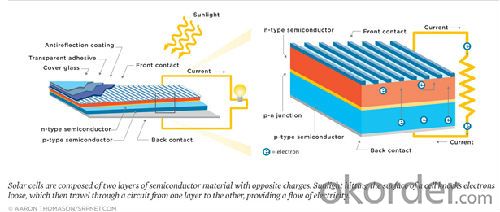
- Q: How can the solar power change our life by using solar cells material?
- 100 years ago, no human being could ever dare to imagine that we can use solar cells to generate solar power to better change our life. Today it is happening everyday!
- Q: How do solar cells perform in areas with high levels of water pollution?
- Solar cells may be adversely affected in areas with high levels of water pollution. The presence of pollutants, such as chemicals or particles, in the water can reduce the amount of sunlight reaching the solar cells, thereby decreasing their efficiency. Additionally, water pollution can lead to the accumulation of dirt, debris, or algae on the surface of the solar panels, further diminishing their performance. Regular cleaning and maintenance are essential in such areas to ensure optimal functioning of solar cells.
- Q: Can solar cells be used for cooking?
- Yes, solar cells can be used for cooking. Solar cookers are designed to capture and convert sunlight into heat energy, which can then be used for cooking food. These cookers utilize solar cells to generate electricity, which can power electric stoves or ovens for cooking. Additionally, some solar cookers directly convert sunlight into heat using reflective surfaces and insulation, eliminating the need for electricity altogether.
- Q: How do solar cells affect the grid?
- Solar cells affect the grid by generating electricity from sunlight and feeding it into the grid, reducing the reliance on traditional power sources. They contribute to a more sustainable and decentralized energy system, helping to reduce greenhouse gas emissions and dependence on fossil fuels. However, their intermittent nature can pose challenges for grid stability and require additional infrastructure investments for integration.
- Q: Can solar cells be used in agricultural farms?
- Yes, solar cells can be used in agricultural farms. Solar energy can be harnessed through solar panels to power various farm operations, such as irrigation systems, lighting, and equipment. This can help reduce reliance on fossil fuels, decrease energy costs, and promote sustainable practices in agriculture.
- Q: What is the impact of leaf litter on solar cell performance?
- Leaf litter can have a negative impact on solar cell performance as it can block sunlight from reaching the surface of the cells, reducing their efficiency and overall power output. Additionally, the buildup of leaf litter can also lead to overheating and potential damage to the solar panels. Regular cleaning and maintenance of solar panels are crucial to ensure optimal performance and maximize energy generation.
- Q: Can solar cells be used in off-grid water desalination?
- Yes, solar cells can be used in off-grid water desalination. Solar energy can power the desalination process, typically through a combination of solar panels and a renewable energy storage system. This allows for the conversion of saltwater into fresh water without the need for a connection to the electrical grid. The energy from the sun is harnessed, stored, and utilized to run the desalination equipment, making it a sustainable and environmentally friendly solution for off-grid water desalination.
- Q: How do solar cells compare to other renewable energy sources?
- Solar cells have several advantages over other renewable energy sources. They are highly versatile and can be installed in various locations, from rooftops to large-scale solar farms. Solar energy is abundant and accessible in most parts of the world, making it a reliable and widely available source of power. Additionally, solar cells have a low environmental impact, as they produce electricity without emitting greenhouse gases or other pollutants. Finally, solar energy is becoming increasingly cost-effective, with declining prices for solar panels and improved efficiency. However, solar cells do have limitations, such as dependence on sunlight availability and the need for large areas of land for large-scale installations. Nonetheless, their numerous advantages make solar cells a valuable and promising renewable energy option.
- Q: Can solar cells be used for powering remote oil and gas pipelines?
- Yes, solar cells can be used for powering remote oil and gas pipelines. Solar energy is a sustainable and reliable source of power that can be harnessed in remote locations. By installing solar panels along the pipeline, energy can be generated and used to operate various equipment and systems, reducing the reliance on traditional power sources and minimizing the environmental impact.
- Q: Can solar cells be used in farming or agriculture?
- Yes, solar cells can be used in farming or agriculture. They can be used to power various agricultural processes such as irrigation systems, lighting, and machinery. Additionally, solar panels can be installed on rooftops or in fields to generate electricity, reducing reliance on the grid and providing a sustainable energy source for farming operations.
Send your message to us
Elon Musk Inspired Poly 3bb 4bb Solar Cells with Low Price 156*156mm
- Loading Port:
- Shanghai
- Payment Terms:
- TT or LC
- Min Order Qty:
- 30000 pc
- Supply Capability:
- 3000000 pc/month
OKorder Service Pledge
OKorder Financial Service
Similar products
Hot products
Hot Searches
Related keywords
